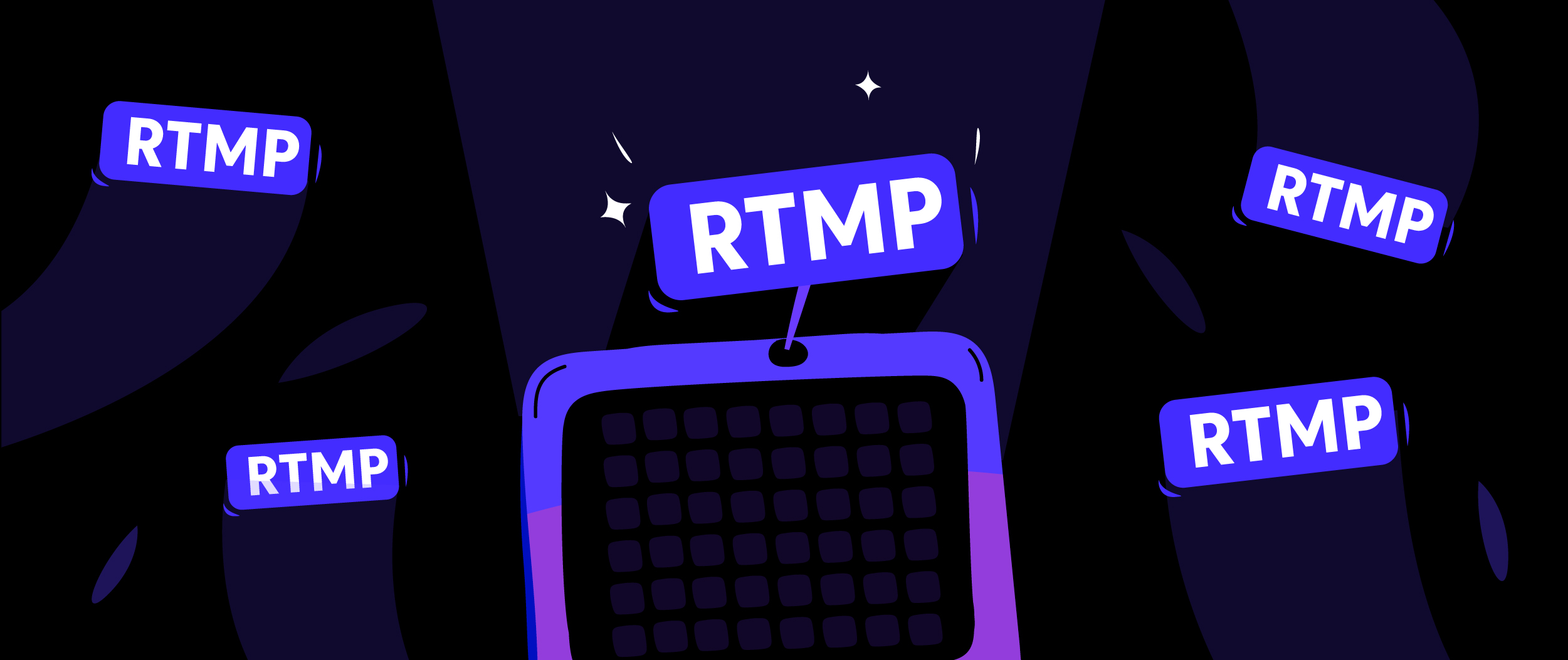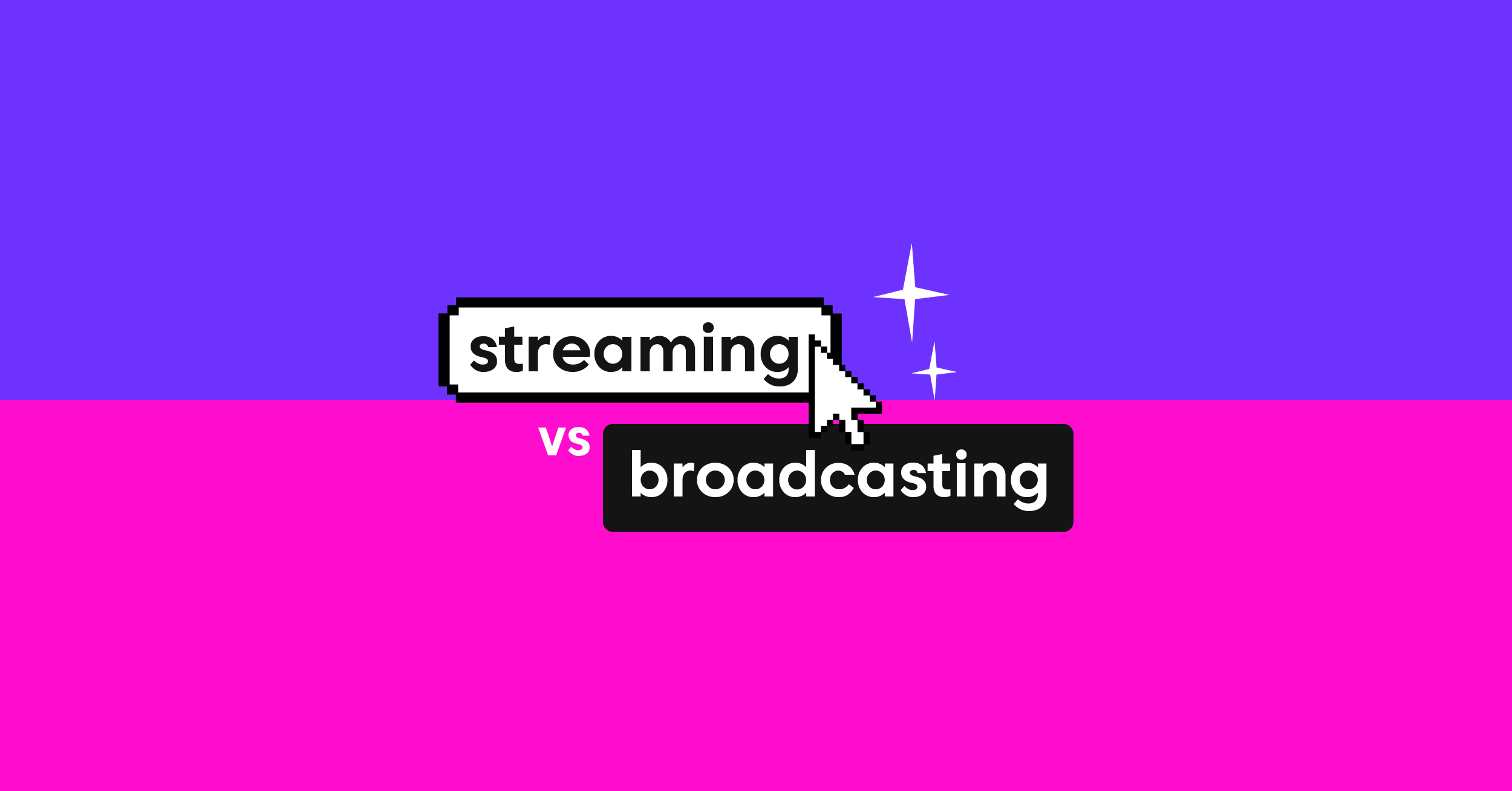Are you in search of the finest streaming protocol for your business? Making a choice between RTMP and RTMPS can prove to be a challenging task due to their significant benefits and drawbacks.
Within this article, we aim to interpret the distinctions existing between the RTMP and RTMPS streaming protocols, aiding you in determining the most suitable one for your requirements.
We will delve into subjects such as their functioning mechanisms, achieving low latency with RTMP, selecting an encoder suitable for RTMP, configuring OBS for RTMPS, and much more. Moreover, we will explore the positives and negatives associated with both protocols, ensuring the security of your streams, and additional tools that enhance the protection of your live videos. Therefore, sit back, relax, and prepare yourself to gain comprehensive knowledge about RTMP and RTMPS – the ultimate showdown in streaming protocols!
What is RTMP Streaming?

Adobe Systems developed the RTMP streaming protocol in 2002 for internet-based audio, video, and data transmission. Although newer protocols like HLS protocol and DASH have largely replaced it, it still requires a media server to send content to viewers.
How RTMP Streaming Works
Real-time messaging protocol variations like RTMP are widely used for live video streaming and on-demand media delivery. The protocol requires a media server to stream content over the internet, while RTMPS provides security by adding encryption during data transmission. Choosing between these protocols depends on various factors, such as security needs and compatibility with audience devices. It’s essential to understand how RTMP works, as it can optimize your streaming setup for faster buffering times and better-quality playback.
The Handshake Process
The RTMP vs. RTMPS debate boils down to security concerns and compatibility with your streaming platform and audience devices. When using the Real-Time Messaging Protocol (RTMP), understanding the handshake process is crucial for troubleshooting issues with your streaming setup. The handshake process establishes a connection between the client and server where they exchange information about their capabilities, ultimately agreeing on how to communicate. To add an extra layer of security, consider using RTMPS, which encrypts all data exchanged during the handshake process. By doing so, you can protect against last-mile delivery attacks or malicious actors attempting to intercept packets during transmission control protocol (TCP) communication.
How the RTMP Connection Works
The RTMP connection process is a protocol designed to enable the live streaming of audio or video content online. To start this process, clients and servers perform a handshake where they exchange details about their communication capabilities. Following the handshake, steps for authentication and data transmission facilitate the safe transmission of packets over the Internet.
The more secure version of this protocol is called RTMPS, which uses SSL/TLS encryption for added security during transmission. Choosing between these protocols depends on your specific needs, such as compatibility with your streaming platform and audience devices, along with the level of security required.
The Basics of How RTMP Streaming Works
The real-time messaging protocol (RTMP) delivers high-quality audio and video content by capturing, encoding, transmitting, and decoding data in real-time. Enhanced security is available with the secure real-time messaging protocol (RTMPS), which uses encryption to offer more protection for streaming.
When choosing between these protocols for your streaming needs, carefully consider your security requirements. Other factors to keep in mind include RTMP servers’ compatibility with various media players and the suitability of encoders for live streams.
RTMP Variations
There are different RTMP variations that you should consider. One version is unsecured, while another one called RTMPS is encrypted and provides better security by using SSL or TLS encryption for data transmission. Even though RTMP has wider support from media players, configuring RTMPS requires extra effort. Factors like security needs and compatibility with existing systems should be considered when choosing a streaming protocol that best suits your needs.
RTMP Server
The RTMP server, also known as the Real-Time Messaging Protocol server, is a technology utilized for transmitting various forms of multimedia content through the internet. Its purpose is to enable immediate communication between a server and a client, thereby making it an optimal choice for applications involving live streaming. Initially created by Adobe Systems, the RTMP protocol has now become an open standard accessible to any media player or server.
RTMP servers are commonly employed by broadcasters, content providers, and similar entities that require the distribution of high-quality multimedia content to a large audience. They offer a dependable and efficient means of transmitting live streams over the internet, ensuring that viewers receive uninterrupted and buffer-free access to top-notch content.
In summary, RTMP servers are a vital element of modern streaming infrastructure, extensively used by businesses and organizations worldwide.
RTMP Alternatives for Ingest
When it comes to RTMP alternatives for Ingest, you have several popular options like HLS (HTTP Live Streaming), SRT (Secure Reliable Transport), and WebRTC (Web Real-Time Communication). HLS uses HTTP for communication and can adapt to varying network conditions, while SRT prioritizes low latency and secure transmission. Live streaming, video conferencing, and other real-time communication protocols can all be accomplished using WebRTC. Consider factors such as security needs, latency, scalability, and compatibility with your existing infrastructure when choosing a streaming protocol that fits your specific use case.
NOTE: RTMP ingest made it possible for RTMP technology to continue streaming video. The predominant method of using RTMP for live streaming is still ingest. Broadcasters benefit from RTMP ingest because it offers low-latency streaming and is made possible by affordable RTMP encoders. Additionally under development is WebRTC HTTP Ingest Protocol (WHIP), which will allow users to stream using simply a web browser as opposed to RTMP’s requirement for encoders.
Low-Latency Streaming with RTMP
If you’re looking for high-quality video delivery with low-latency streaming, then consider using the RTMP protocol. To ensure a smooth streaming experience and last-mile delivery of your content to viewers, choose a compatible video player and CDN. For added security while transmitting your streamed content over the internet, use the encrypted version called RTMPS. It adds an extra layer of encryption to protect your videos from unauthorized access. Depending on the level of security required for your live streaming needs, choose either RTMP or its secure counterpart, RTMPS.
Choosing an Encoder for RTMP Streaming
To choose an RTMP encoder for an RTMP stream, consider its features and capabilities, such as compatibility with your streaming platform and customizable settings. Also, look for an encoder supporting the RTMPS protocol to add an extra layer of security to your video content. Check the ease of use and user interface of the RTMP encoder you choose. Compare pricing and subscription options for different encoders before making a decision based on your budget. By keeping these factors in mind, you can ensure a smooth streaming experience without compromising on security.
Pros and Cons of Using RTMP Protocol
RTMP stands as a widely recognized streaming protocol acknowledged for its ability to deliver top-notch video content over the internet with minimal latency. Its key strength lies in its outstanding performance when it comes to live streaming situations. Nonetheless, employing RTMP does entail certain drawbacks, including compatibility challenges with specific devices and firewalls that impede the final leg of video stream delivery.
To address these limitations, broadcasters have the option to use RTMPS, which represents an encrypted version of the protocol, guaranteeing secure transmission control between the server and the client. While adopting this protocol may demand additional resources compared to RTMP alone, it offers enhanced security advantages that overshadow the extra costs.
Understanding RTMPS

Using Secure Socket Layer (SSL) or Transport Layer Security (TLS) certificates, the RTMPS Protocol offers a way to safeguard data exchanged over the internet. By doing so, it establishes a secure link between the server and the client, heightening confidentiality/privacy and protecting unauthorized entry to sensitive data/information. In comparison to RTMP, this protocol delivers superior security measures for streaming content.
While it may exhibit reduced speed compared to RTMP, its elevated level of security deems it a fitting option for broadcasters who prioritize privacy over speed. Over the past years, the RTMPS Protocol has gained significant popularity owing to its capability to ensure the secure delivery of video content up to the final destination.
What is the RTMPS Protocol?
RTMPS is short for “Real-Time Messaging Protocol Secure,” an encryption standard used to secure RTMP data. It is widely utilized in video content streaming that requires privacy and security. Leading live streaming platforms, such as Facebook and YouTube, support RTMPS streaming.
RTMPS Mobile Streaming: How to Secure Your Live Streaming from Mobile Devices
To secure your mobile streaming with RTMPS, use software that supports the protocol and obtain an SSL certificate. Ensure your settings are configured correctly, update software regularly, and monitor for vulnerabilities to enhance security. RTMPS uses SSL/TLS encryption to protect data.
How to Configure OBS for RTMPS Streaming
If you want to use OBS for RTMPS streaming, you need to follow some necessary steps. Ensure that your server supports RTMPS and obtain an SSL certificate to encrypt data for added security. Open OBS Studio and select “Settings.” Click on “Stream,” choose “Custom Streaming Server,” and enter your server’s address along with the stream key using transmission control protocol (TCP). For encoding, choose Adobe Flash Player’s action message format (AMF) or the open-source Real-Time Messaging Protocol Encoder (RTMP). Test your configuration to make sure it runs smoothly before going live.
Pros and Cons of Using RTMPS
RTMP vs. RTMPS has been a hot topic in recent years, with live video content booming on the internet. Choosing between these two streaming protocols can be confusing for broadcasters. RTMPS adds an extra layer of security by encrypting the data being transmitted, making it a safer option for streaming. The majority of current web browsers and mobile devices, including Facebook and YouTube, support it. Compared to its predecessor, the Macromedia (now Adobe) RTMP protocol, implementation of RTMPS can be more challenging and may call for more resources and expertise.
However, using RTMPS may result in slower streaming speeds due to the added encryption process. To secure live video content from mobile devices using RTMPS, you need to use a streaming app or software that supports it, obtain an SSL certificate, configure your settings to use the protocol, update your software regularly, monitor for security vulnerabilities, and ensure last-mile delivery.
RTMP vs. RTMPS: What’s the Difference and Which Streaming Protocol to Choose
When discussing streaming protocols, there are two widely known options called RTMP (Real-Time Messaging Protocol) and RTMPS (RTMP Secure). These protocols have unique functionalities and features, making it vital to comprehend the distinctions between them in order to choose the right one for your streaming needs. This article aims to delve into the features of both protocols and offer guidance on selecting the most suitable option for your streaming requirements.
Over the Internet, real-time data, audio, and video are typically transmitted using the Real-Time Messaging Protocol (RTMP). Transmission Control Protocol (TCP) underpins its operation, ensuring the consistent and orderly transfer of data packets between a server and an RTMP client. RTMP is commonly utilized for low-latency streaming, making it suitable for applications such as live streaming, online video platform, and video communication.
Conversely, RTMPS is the secure variant of RTMP. Secure Sockets Layer (SSL) and Transport Layer Security (TLS) are two of the encryption protocols it employs to make data transmission more secure. This encryption ensures the privacy and protection of video content and other transmitted data, safeguarding them against unauthorized access. RTMPS proves particularly beneficial when transmitting content over public networks or when prioritizing security in streaming solution.
Both RTMP and RTMPS possess their individual advantages and use cases. RTMP is often associated with Adobe Flash Player and was widely used before the emergence of HTML5 and other modern streaming technologies. It establishes a constant connection between the client and server, facilitating real-time streaming and interactive features like chat or synchronized playback. RTMP is compatible with various streaming servers and media players, making it a versatile option for streaming video files.
In contrast, RTMPS provides a secure and reliable means of transporting streaming data. It guarantees that the video stream and sensitive information, such as stream keys or session IDs, remain encrypted during transmission, minimizing the risk of data breaches. Prominent streaming platforms like YouTube Live and Facebook Live commonly use RTMPS to ensure secure live streaming, protecting user data and preserving privacy.
When deciding between RTMP and RTMPS, carefully consider your specific requirements and priorities. If low latency and real-time streaming are crucial to your application, RTMP is a suitable choice. However, if you need to securely deliver content over public networks or prioritize data protection, RTMPS is the recommended option. Additionally, keep in mind that modern streaming technologies like HLS (HTTP Live Streaming) have gained popularity, providing alternative choices to both RTMP and RTMPS.
To conclude, the selection between RTMP and RTMPS relies on your specific streaming needs and security requirements. RTMP is a well-established protocol for low-latency streaming and interactive features, whereas RTMPS adds an additional layer of security for secure live streaming. Evaluate the features, compatibility with your streaming platform, and the desired level of security to make an informed decision. By comprehending the distinctions between these protocols, you can select the streaming protocol that best suits your requirements, ensuring a seamless and secure streaming experience.
KEYNOTE: RTMP is unsecured, while RTMPS adds an SSL/TLS layer to encrypt data. Some platforms require RTMPS for security. Choose based on the level of security needed for live streaming.
RTMP vs. RTMPS: Which is Safer?

When it comes to security, RTMPS is considered safer than RTMP. This is because RTMPS encrypts transmitted data and uses the more secure HTTPS protocol compared to RTMP’s HTTP. It’s recommended to use RTMPS if security is a concern.
Securing RTMP and RTMPS Streaming
To enhance the security of live streaming applications that transmit sensitive or private content over the internet using the real-time media flow protocol (RTMP), it’s advisable to use its secure counterpart, RTMPS. Using Secure Socket Layer (SSL) or Transport Layer Security (TLS) encryption establishes a secure connection between the client and the server. While implementing this takes extra effort and configuration on the server end, its benefits outweigh the effort required for both broadcasters and viewers alike.
RTMPS, RTMPT, RTMFP, RTMPE, RTMP Proper – Variants of RTMP
Streaming protocols like RTMP and RTMPS have emerged in response to the rising popularity of online video broadcasts in recent years. Streaming protocols like these have become crucial for transmitting video content over the internet seamlessly. Real-time messaging protocol variations include protocols such as RTMPT, which is tunneled through HTTP and uses TCP to send packets.
However, the real-time media flow protocol (RTMFP), which is employed in P2P streaming and communication, has grown in favor. While choosing the protocol that best suits your needs is essential, it’s also important to ensure that you prioritize security measures such as SSL/TLS encryption offered by protocols like RTMPS.
Additional Tools for Secure Streaming
To ensure the secure transmission of video content, broadcasters must employ additional tools for implementing further security measures. Such measures include SSL certificates and encrypted streams that offer robust protection against data breaches. While choosing the right streaming protocol based on specific needs is crucial, using an open-source media server like OBS Studio can ensure low-latency streaming with improved security features.
Further tools such as a firewall, last-mile delivery, and bandwidth optimization can help in improving overall security and streamlining the transmission control protocol (TCP). Understanding the differences between various encryption methods, such as the SSL and TLS encryption protocols used in RTMPS, can significantly enhance security while transmitting audio and video data over the internet.
Other Tools for Secure Streaming:
Some of the other top tools for protected streaming include:
- Password protection
- Double-factor authentication (OVP login)
- AES encryption
- Tokenized security
- Geographic/IP restrictions
- Domain restrictions
Conclusion
To sum up, RTMP and RTMPS possess distinctive features that render them appropriate for various streaming purposes. RTMP stands out for its speed and user-friendliness, whereas RTMPS offers superior security and privacy. It is crucial to select the right protocol according to your specific requirements and objectives. Furthermore, you have the option to utilize supplementary measurement tools such as firewalls, VPNs, and SSL certificates to further bolster security.
Frequently Asked Questions
What is the difference between HTTPS and RTMPS?
HTTPS is a secure internet communication protocol, while RTMPS uses HTTPS to secure the transmission of video data for live streaming. While HTTPS is mainly used for web browsing, RTMPS is to exclusively live stream video content. Choosing between the two depends on your needs and the content being transmitted.
What is RTMPS, and why is it important to secure streaming?
RTMPS is a secure version of the RTMP protocol that encrypts streaming content to protect its privacy and security. Unauthorized parties may view streams that are not secure. RTMPS is especially important when streaming sensitive or confidential content like financial data, medical records, or private events.
Why do streaming platforms use RTMP and not RTSP?
Streaming platforms prefer RTMP over RTSP due to its wider support, better performance, and adaptive bitrate streaming. Additionally, RTMP enables complete control over the video delivery process.









